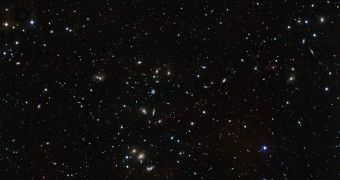Using some of the most advanced scientific instruments on the planet, a team of astronomers was recently able to image a huge galactic collision in the Hercules cluster (Abell 2151). The cosmic formation is located about 500 million light-years away from Earth.
In order to snap an image with this level of clarity, investigators used the Very Large Telescope's (VLT) Survey Telescope (VST). The OmegaCAM scientific camera was selected as the primary detector.
This installation is located at the Paranal Observatory in Chile, a facility operated by the European Southern Observatory (ESO). It took experts only three hours to snap impressively-detailed images of the cluster at high resolution levels.
One of the things separating Abell 2151 from other clusters is its irregular shape. Additionally, experts also found it's made up of several distinct types of galaxies, of which some are still forming new stars.
Equally mysterious is the total absence of giant elliptical galaxies. The latter are believed to be very old, and the result of massive collisions between several spiral or barred spiral galaxies.
All these details could be made out using the 268-megapixel OmegaCam instrument. It is capable of covering a large portion of the night sky, but it can zoom in on specific objects with extreme ease.
One of the reasons why the VST/OmegaCam combo can snap such sharp and deep images so quickly is because they are built atop Cerro Paranal, in the Atacama Desert. The atmosphere here is extremely dry, and precipitations fall to the ground maybe once a year.
“The Hercules galaxy cluster is believed to be a collection of at least three small clusters and groups of galaxies that are currently being assembled into a larger structure. Furthermore, the cluster itself is merging with other large clusters to form a galaxy supercluster,” an ESO press release reports.
“These giant collections of clusters are some of the largest structures in the Universe. The wide field of view and image quality of OmegaCAM on the VST make it ideal for studying the outskirts of galaxy clusters where the poorly-understood interactions between clusters are taking place,” the statement adds.
The entire central portion of the image to the left is covered in galaxies that are in the process of colliding among themselves. Eventually, all of them will condense to form a larger structure, which will probably start to get attracted by a different supercluster.

 14 DAY TRIAL //
14 DAY TRIAL //